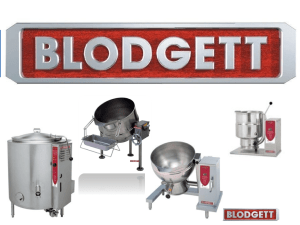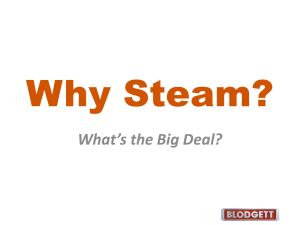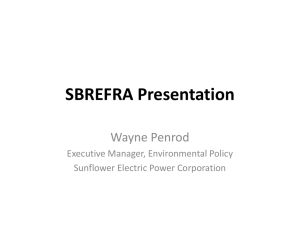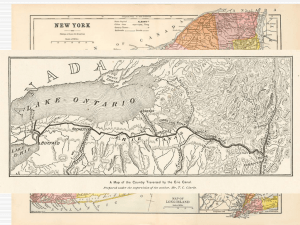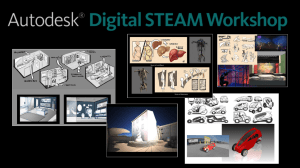tilting - Blodgett Oven
advertisement
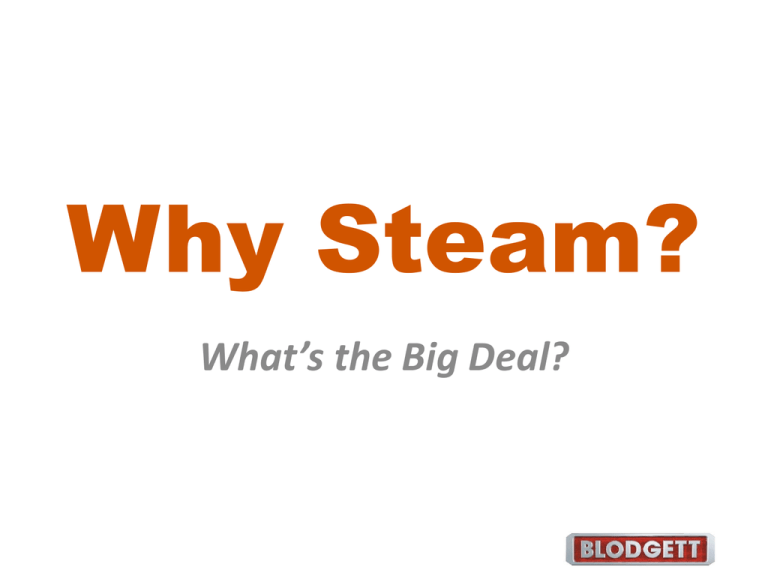
Why Steam? What’s the Big Deal? Cooking Energy Sources • Radiation – visible light, infra-red, microwaves • Convection – heated air, steam • Conduction – contact with a heated surface or liquid Steam Cooking • Braising Pans (as a steamer) – boiling water provides atmospheric pressure steam (0 PSI) 212° F. Air acts as an insulator and slows cooking, compared to a “true” steamer. • Kettles – jacket wall heats to the steam temperature, pressure inside jacket gives a temperature above 212° F for cooking. • Steamers/Combis – steam at atmospheric pressure (0 PSI) 212° F condenses on food surface and transfers latent heat directly. Heat versus Temperature • Heat is energy – the energy of molecular motion in a material • Temperature is a measure – the measure of kinetic energy of the molecules in a material Boiling v. Pressure • The temperature where water changes to steam varies depending upon the pressure • At sea level (~14psi), water boils at 212°F • At 6000’ water boils at 201°F • At 50psi water boils at 298°F Temperature is related to Heat… • One BTU is the heat required to raise the temperature of one pound of water by 1°F …but not always • Sometimes heat changes the structure (phase) of a material instead of raising the temperature – Ice to Water – Water to Steam Why Steam? • Definition: Steam – invisible gas into which water is changed by boiling [Oxford American Dictionary] • Advantages: – – – – Flows easily through pipes and tubing Carries more energy than air or radiation “Wants” to become water Has no odor or taste • Disadvantages: – “Wet” environment – does not “brown” – Pressure and burn hazards – Lime scale Enthalpy of Steam • BTU (British Thermal Unit) = the amount of heat required to raise the temperature of one pound of liquid water by 1 degree Fahrenheit at its maximum density, which occurs at a temperature of 39.1 degrees Fahrenheit. One BTU is equal to approximately 251.9 calories or 3.7 Watts. • Enthalpy = heat content capable of doing work • Sensible heat = portion of heat content introduced into water raising it from 32 to 212 degrees Fahrenheit (at 212° = 180 BTUs) • Latent heat = amount of heat energy introduced into 212 degree water to convert it into 212 degree steam (= 970 BTUs at atmospheric pressure) Sensible and Latent Heat • Sensible heat is the heat that changes the temperature of a material – it can be sensed • Latent heat is the heat associated with a phase change of a material – it is “within” the material but not sensed by a temperature change Latent Heat does the Cooking STEAM WATER Pressure and Temperature • As pressure increases, so does the sensible heat and temperature of steam • Latent heat decreases slightly PRESSURE TEMPERATURE SENSIBLE HEAT LATENT HEAT 0 PSI 212° F 180 BTU 970 BTU 5 PSI 227° F 195 BTU 961 BTU 15 PSI 250° F 218 BTU 946 BTU 50 PSI 298° F 267 BTU 912 BTU 100 PSI 338° F 309 BTU 881 BTU Heat Transfer • The heat transfer rate of condensing steam is much greater than the heat transfer of air convection • Example: you can put your hand into a 212°F (or higher) oven momentarily and not get burned • DO NOT put your hand into steam at 212°F. You WILL get burned. Steam Cooking • Steam is created when water absorbs heat (latent heat of 970 BTU/lb) and changes to steam…but the temperature stays at 212°F • Food is cooked when steam condenses on the food and releases its latent heat • AND THAT’S A LOT OF HEAT!! Summary • Steam cooks because it releases a large amount of heat to the food. • This process occurs when the steam condenses to water, releasing the latent heat. • The heat transfers more rapidly than normal convection air cooking. • The product remains moist. Industry Pressures/Boilerless Manufacturer standards increasing New certifications available (rebates) Energy Star, Green Rest., Even LEED Three questions all potential customers should be asked? What product are you planning on steaming? vegetables, starches, proteins, re-therming or seafood? In what manner are you planning on steaming? batch, versatile or ala carte What volume do you need? How many pans? Defining Application Style/ Steamer need Coil Pressure Steamer Remote Boiler Higher temp. Quicker cook times No manual intervention High energy use High water use Loss of time on pressure down flavor transfer Hard on delicate vegetables Tend to leak at door gaskets Boiler Steamers Most sold today are open systems allowing for ala carte style cooking. Atmospheric steam in lieu of pressure in the cooking cavity. Having a boiler allows unit to be used as a single source power supply for existing or new direct steam kettles. Provides availability to meet spec and or customer predisposition that a boiler system is what they want. Accessible cavity (ala carte cooking, fastest recovery time, easy on vegetables, no flavor transfer) High water usage, high energy use, demands high maintenance, requires harsh chemicals, boilers are the most problematic piece of equipment In the kitchen. High cost of ownership. Generators vs. Boilers What's the difference? 1970’s zero pressure and a call to eliminate the boiler requirement. To preserve food integrity, “zero” pressure steamers have an advantage over pressure steaming Open system/closed system Accessible cavity (ala carte) Still all the issues that boiler steamers have minus the requirement of a boiler… Boilerless Steamers Economic and ecological pressures move steamers to boilerless technology. What is boilerless? To preserve food integrity, “zero” pressure steamers have an advantage over pressure steaming Open system/closed system Accessible cavity (ala carte) or Batch Still all the issues that boiler steamers have minus the requirement of a boiler… Why boilerless is better. Less water consumption than traditional steamers. (saving money on utilities) Less maintenance required (no traditional de-liming of generators or boilers. (saving money on labor) No harsh chemicals (unit cleans up with simple vinegar and water solution) meaning less cost of cleaning agents and less impact on environment. Very near the same cook times as a generator unit (with all the savings) Additional benefits of Connectionless steamers Utility Study Studies conducted by Fisher-Nickel, Inc. and the Foodservice Technology Center confirm that replacing a conventional steamer with a connectionless steamer in a high volume restaurant will save $6,083.00 each year per compartment in utility savings. That is $12,166.00 each year per double stack steamer! The information in this table is based on data generated by Fisher-Nickel, Inc. and the Food Service Technology Center - MWD ICP: Evaluating the Water Savings Potential of Commercial Connectionless Steamers - Agreement No. 55354- Final Report “Boilerless” Batch oriented Holding Cabinet Energy Star Rated Variable capacities, 3,6 Electric Digital timer Water Connection optional Water filter optional Easy to clean (mirrored interior) High rate of continuous steam “Boilerless” Connected a la carte style Boilerless base Variable capacities, 3,5,10 Electric/Gas 90 minute digital timer (each cavity of stacked) Single water connection Water filter optional Easy to clean (mirrored interior) High rate of continuous steam Steam Generator Generator base Variable capacities, 3,5,6,10 Electric/Gas Separate 60 minute timers Available with two water connections Water filter recommended Steam on demand Versatile steamer able to dispose of the waste from shell fish Boiler Based Boiler (in cabinet base) Installation required Needs deliming and daily blow-down Heavy water usage Rapid recovery and high steam production A la carte/heavy duty production steaming Can power adjacent kettle Competitive features First of All, What is a Steam-Jacketed Kettle? It’s a Pressure Vessel Designed to Transfer Heat or Energy From Itself to the Product Inside it. How it Works… Hemispheres, ASME, Energy, Pressure, Conduction. Steam Jacketed Kettle Replaced the Stock Pot on the Open Range Why Use a Kettle? Labor Savings Product Quality Safety Energy Efficient Ease of Cleaning Low Interaction with Acid Foods Ergonomics Space Limitations Kettle Categories • Direct Steam Kettles (Require a Boiler) • Self-Contained Kettles (Gas or Electric) Sub Categories • Table top, Stationary Floor, Tilting Floor Direct Steam Oldest of All Kettle Designs Requires External Steam Source (Boiler) Broad range of Sizes Least Temperature Control Self-Contained Gas Kettles Heat Exchange System Between the Kettle Jacket and Gas Burner Thermostatic Control of Gas Burner Natural Gas and Liquid Propane Altitude Sensitive Medium Efficiency Stationary and Tilting Self-Contained Electric Kettles Elements Located Within the Jacket Thermostatic Control of Elements Voltage Dependent High Efficiency Stationary and Tilting Table Top Kettles Stationary vs. Tilting STATIONARY • Unlimited Size • Smaller Footprint • Insulated • Draw-Off Provided • Harder to Clean TILTING • 80-Gallon and Below • Larger Footprint • Non-Insulated • Draw-Off is Optional • Easier to Clean Cooking Energy Source Kettles Cook Via Contact with a Heated Surface Heat-Up and Cooking Speed are Determined by: • • • • Jacket Coverage – 1/2, 2/3, Full Steam Pressure Determines Temperature Movement of the Product Inside Kettle Heat Loss on the Walls and Upper Surface Pressure and Temperature PRESSURE TEMPERATURE SENSIBLE HEAT LATENT HEAT 0 PSI 212° F 180 BTU 970 BTU 5 PSI 228° F 196 BTU 960 BTU 10 PSI 240° F 208 BTU 950 BTU 15 PSI 250° F 219 BTU 945 BTU 35 PSI 281° F 250 BTU 924 BTU 50 PSI 298° F 267 BTU 912 BTU 100 PSI 338° F 309 BTU 880 BTU Speed & Volume Production Heats 1/3 Faster than Stock Pots Larger Single Batches Easier Product Transfer Safety Permanent Attachment to Stand or Base SelfContained Heat Source Protection – Pressure, Temperature, Power Precise Control Over Draw-Off and Pouring Energy Efficiency Greater Heated Surface Area SteamJacket Heat Source – Electric, Gas or Direct Precision Heat Control Ease of Cleaning Even Spread of Heat – No Burnt on Food Drain or Tilt Mechanism for Access Low Acid Interaction Stainless Steel Construction Type 316 with Molybdenum Added for High Resistance to Acid Foods Ergonomics No Heavy Lifting Single Person Operation Low Impact Tilt and Crank Mechanisms Positive Stop On Crank Systems Controls in a Viewable Location Space Limitations Footprint is Less as Volume Increases – Compared to Multiple Stockpots Free up Range top Space for Pan Frying and Other Techniques Free up Sink Space for Smaller Pots and Pans Kettle Sizing Chart Working vs. Nominal Capacity Allow for Growth Multiple Kettle Flexibility Competitive Feature Sheets The Braising Pan Modern Braising Pan Braising Pan Versatility Griddle Pancakes, Sausage and Eggs Cook Soup and Grill Hamburgers Boil Pasta & Sauce and Steam Vegetables Stir-Fry an Entrée or Slow-Cook a Roast Make Pudding Braising Pan Sizing • Working vs. Nominal Capacity – surface area or pan volume • Allow for Growth • Multiple Pans add Flexibility Floor Model Braising Pans 30 & 40-Gallon Capacity Electric, Natural Gas and Propane Electronic Ignition or Standing Pilot (Gas, Manual-Tilt Only) Center Tilt Open Frame – Tubular Leg Available on CASTERS TD/FPC Table Top Braising Pan Manual-Tilt 10-Gallon Electric Only Optional Stand and Drain Cart Lid Features Safety First Inside Brodgett Gas Braising Pans Control Box Thermostatically controlled Tilting Cut-Off Switch 24 turn worm gear Power tilt available Water resistant controls Faucet bracket standard Tilting control “Worm Gear” Gas units – Uses fins to distribute energy Short and Long Fins that Capture Burner Assembly Uneven cooking in competitive models Electric elements attach directly to the bottom of the pan Electric Elements Braising Pans Cooking Surface Sanded Finish Holds the oil 3” Radius Corner Prevent corner scorching Coved Sides Use rounded utensils Gallon Etch-Marks Volume control 5/8 inch clad plate Even Heat Cooking Surface Which Braising Pan Would You Rather Spend The Next 20 Years Cleaning??? Why open legs? Why open leg stands vs cabinet style 1) No Pinch Points for accidents to happen. 2) No hiding places for vermin or infestations. 3) Far easier to clean (saving Time) Accessories Competitive features sheet

